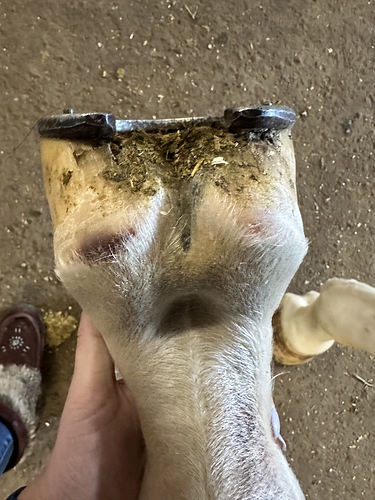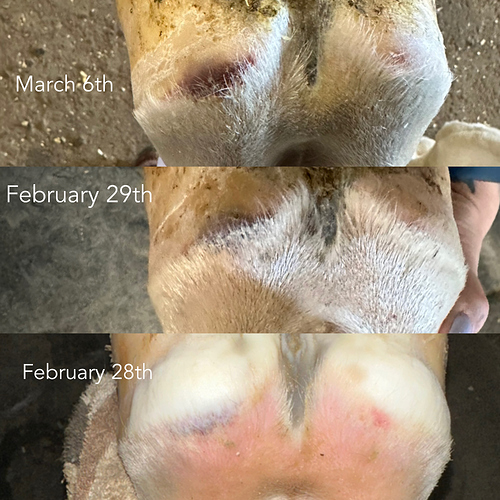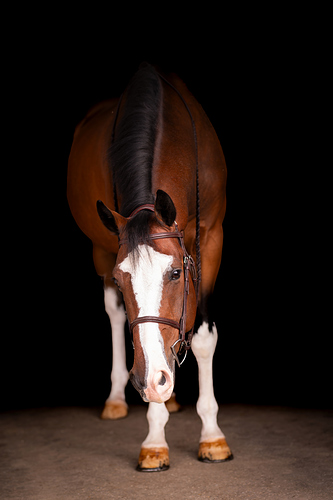Hello everyone, I have been a long time reader but first time poster today, as if finally met my match for a very troublesome guy.
I have a coming 7 year old Canadian Warmblood gelding, I purchased him as a colt and had planned to bring him up as a stallion in my area due to his blood lines. Well that wasn’t in the cards for this guy.
As he grew, we noticed some conformational flaws which we knew could impact him as he aged, and we have worked with them as he gives them to us as an issue, we do not change anything that doesn’t need to be changed.
We put shoes on so he doesn’t wear his foot down, and worked with the vet and farrier to find the best trim and angles to keep the skeletal conformation inside the hoof and the leg happy. (Some may think this looks odd but this works for him and keeps him comfortable and sound - minus the new bruise that were seeing).
2021 we found bilateral fetlock chips - deemed OCD we had them removed and then decided to geld him as some say this can be passed down genetically.
2022 January he is gelded.
Two successful show seasons in his books competing up to the 3’6 hunter derbies by he end of 2022 but had a weird hop that we decided to investigate further in October 2022.
October 2022 - lame in the left front and
the left hind limb. The left front limb had a large injury to the superficial digital flexor tendon. On ultrasound the tendon was found to be severely enlarged for most of the cannon region. The left hind stifle was found to have soft tissue injury on ultrasound. There was an injury to the medial meniscus and the medial collateral ligament.
Fast forward PRP and 3 rounds of shockwave on both injuries. We rehabbed him VERY slowly and gradually and he did not do much in terms of more than 4 days a week for work throughout 2023. We got the green light to start very slowly jumping him in January 2024, and we did 3 crossrails one day, he was great, no issues and nothing.
Next lesson we did the exact same to build him back up slowly, he did save me a couple times as I am also out of shape, chipping to the fence, which makes me think he may have stepped on himself quite hard.
After this lesson, I noticed that he was stepping a bit more favourable on that right front foot (remember this is one of the limbs that had no injury other than his conformation issues that he was born with).
We thought abscess, treated like an abscess for 2 weeks (vet came out and xrayed, saw a gas pocket in the lateral heel - no broken bones within the foot, but potentially saying that an MRI may help us to see if it is a tendon on ligament). Nothing burst.
Vet came out again. We tried a week of antibiotics and a week of previcox, to see if it helped. He was also blocked on this appointment and it is located down to his hoof specifically. Which is good to know it’s nothing higher up and we’re in the correct spot.
Horse is the same amount of sore.
Now on the heel bulb, lateral more than medial, he has darkened areas that seem to be bruising coming to the surface. (I have photos from when we noticed the soreness, and the two dark areas on the heel bulbs (left is darker than right).
After this lesson, i noticed that he was stepping a bit more favourable on that right front foot (remember this is one of the limbs that had no injury other than his conformation issues that he was born with).
We have done Right Front Coffin Bone, Hock, and Stifle injections, and he is on supplements helping with recovery and 4Cyte.
Now, those limbs have been amazing, with not one issue or concern with movement or issues on lameness exams since injections.
** I don’t need advice on the shoeing, on our choices for maintenance or anything other than the question I have asked about the darker spot. I gave background information to help paint a photo.
My question is, has anyone seen anything similar, or dealt with something remotely similar.




